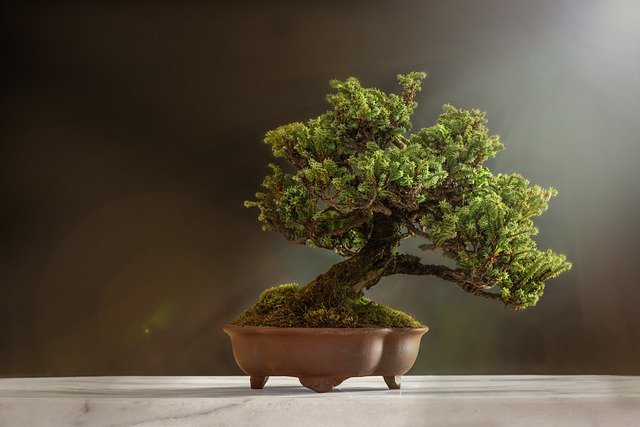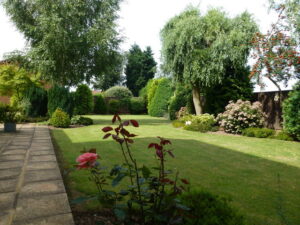Indoor bonsai trees have gained momentum in recent years because they beautifully transform your indoor spaces. They go beyond the normalcy of the typical indoor plants with their instant focus and unusual aesthetic that boosts your inner peace.
Indoor bonsai trees bring a calm atmosphere to your home or office, and it’s one of the best investments you can make. If you can adequately take care of your bonsai trees, you can look forward to a lifetime of beauty and calm around your living spaces.
Most bonsai trees for indoors are either semi-tropical or tropical and are quite affordable. However, they need a lot of care. You need to have adequate gardening skills and expertise to ensure your bonsai trees grow healthy.
Naturally, bonsai trees require direct sunlight and more water. Therefore, make sure you place your indoor bonsai tree where there is direct sunlight since artificial lights may not be sufficient for them to photosynthesize. However, it’s important to note that some species survive with fluorescent lighting.
Never expose your indoor bonsai trees to the freezing cold during winter or more heat in summer. Also, ensure you have a better know-how of the cultural needs of bonsai trees since some mistakes will lead to your trees dying.
How to Take Care of Your Indoor Bonsai Trees
Bonsai trees are grown in containers or pots, and they are meant to remain small for their entire life. This is done by placing your bonsai tree in a small container or pot that confines the tree roots for minimal growth. Bonsai trees need the following care:
Watering
Bonsai trees need a lot of water for them to thrive vibrantly. However, overwatering threatens your bonsai tree’s health. The ideal way to ensure you are properly watering your bonsai trees is using your sense of touch.
Constantly water your trees when the soil gets dry and allow proper soaking. Ensure you know the specific requirements of your bonsai tree because some species such as Jade require an extended period of dryness.
Never use overhead watering since it dislodges the soil and may end up damaging your trees. When watering your bonsai trees, you can immerse your tree in a bucket or spray from a hose.
Nutrients
Nutrients are crucial for your tree’s health, and since bonsai trees grow in a limited space, they tend to deplete their nutrients much faster. Therefore, ensure you regularly replenish your bonsai soil with phosphorous, nitrogen, manganese, zinc, potassium, copper, and iron.
The nutrients required by bonsai trees depend on their different species. Before applying any fertilizer on your bonsai trees, carefully read the label because over-fertilizing will instantly affect your trees. You need to fertilize your indoor bonsai trees throughout the year.
Light
Light is a vital care requirement for your bonsai trees. Bonsai trees can’t grow without light since they will start to dry off. They require direct sunlight for around six hours a day, failure to which can lead to slow growth. If the sunlight is not much intense, your bonsai trees will need more hours than that.
Some bonsai trees need more sunlight than others, with some extending up to 16 hours a day. Therefore, make sure you place your indoor bonsai trees on a bright windowsill to have full access to sunlight.
Soil
Bonsai trees grow healthy when you plant them on bonsai soil since it contains essential nutrients for these tree types. The soil should have proper air circulation and well-drained to allow better water flow through the drainage holes to prevent root rot or soggy soil.
Humidity
Humidity is one of the hardest bonsai trees’ requirements to get right. Both tropical and sub-tropical bonsai trees need high humidity levels, just as in their tropical habitats. Our houses are not humid, but you need to create a moist environment for your bonsai trees to grow well.
You can use an electric humidifier to increase your home humidity level. This is the easiest way since you only need to plug in and continue with your daily chores. However, the initial purchase cost, together with its running costs, is very high. Also, your loved ones with not enjoy staying in a humidified room.
The easiest way to increase the humidity level in your home is by spraying your bonsai trees with a fine water mist. The method is cost-effective, but you need to spray frequently every day, which may not be practically possible if you have a busy life schedule.
Temperature
Tropical bonsai trees are suitable for indoors because they need warm temperatures throughout the year. They survive better at any room temperature that you are comfortable with. You only need to keep them away from open windows to prevent them from extreme cold or heating vents to prevent them from drying out.
On the other hand, sub-tropical bonsai trees can withstand low temperatures during the winter season. This allows them to do very well in unused rooms, which you don’t have to heat over winter. Also, sub-tropical bonsai trees do well even in warm temperatures.
Pruning
Pruning is an essential activity for the beauty and health of your bonsai trees. It would help if you were more cautious when pruning your bonsai trees to prevent damaging them.
Some bonsai species grow faster than others, hence the need for regular pruning. Buds’ removal will enhance small leaves growth. You need to reduce scarring since it takes time for your bonsai trees to recover.
There are two types of pruning: structural pruning and regular pruning.
Structural pruning is cutting large branches to achieve your desired bonsai size and needs to be done maybe twice a year.
Pests and diseases
All bonsai trees are susceptible to pests and diseases. Some of the common pests that attack bonsai trees include mealybugs and aphids. If you notice pests infestation on your bonsai trees, make sure you apply some sprays.
Overwatering and lack of enough nutrients are diseases that can affect your bonsai trees. Ensure you apply enough fertilizer and avoid overwatering.
Best Bonsai Trees for Indoors
Ficus Retusa is the most popular species of bonsai. Some species of the Ficus tree can grow very large with a crown circumference of more than 300 meters. All Bonsai fig species have that milky latex sap that leaks when it gets a cut or a wound. The tropical figs are usually evergreen trees, with small shrubs and sometimes climbing plants. Some of the species can produce flowers while many ficus species have some hidden flowers in a small receptacle where their fruits grow. When it’s time for pollination of flowers, only some fig wasps that are specialized for pollinating can do that. The fruits can be red, green, yellow, or even purple and are more often between a millimetre to centimetres just like the edible fruit of the Ficus Carica.
Most of these Ficus Bonsai trees in their natural habitat can produce aerial roots. For aerial roots to thrive in your home, a humidity of almost 100% needs to be achieved artificially. This can be done through the use of a fish tank, covered with glass, or even a construction that has a transparent sheet for this course only. The roots grow vertically from their branches and thereafter developing into some strong pillars like trunks after reaching the soil.
Features
- The tree is a unique idea to give to someone.
- It is easy to take care of it as an indoor plant
- The colours of the pots vary. Can come in green, blue, or cream with a matching ceramic tray.
- Thrives well in sunny and warm locations. Requires watering at least once a week.
This kind of tree can be more than just a miniature Japanese tree. In fact, this kind of art/hobby is among the most appealing features of having a Bonsai plant in for your indoor décor. The main purpose of planting a Bonsai tree is to create a miniaturized but realistic representation of nature using a tree. The art of growing Bonsai trees originated from the Chinese empire and just like other forms of arts, the Japanese copied this culture and hence adopted it during the period of Kamakura.
Features
- Bonsai trees are not only best for the homes and offices indoors décor when it comes to helping in enhancement of that aesthetic appeal but also for the several other psychological and health benefits since they play a role in purifying the air in the surroundings.
- They are very easy to maintain, hence suitable for a beginner who has no much experience in taking care of these kinds of trees. They take not much of your time, therefore, you can do your other things.
- This Bonsai is suitable for those who love yoga meditation using plants. These small trees are best known as stress relievers. This is the reason you will find so many spaces such as offices, kitchens, and bedrooms.
- It’s among those thoughtful gifts to someone, be it a Christmas gift, birthday, or wedding gift.
- This Bonsai tree is great fun and can as well make you patient and active. It allows you to learn some of the biggest life lessons of hard work and to be patient for you to get the fruits. There is a new way of potting called the moss and usually comes when already fertilized for two months. You will only need a tray then allow it to sit on it well.
- It is easy to take care of it. You simply need to submerge it in water for five minutes every 6 to 9 days then subject it to sunlight.
- The best thing about this kind of Bonsai tree is the fact that they can live for many decades and it has become so popular in the world since, with time, it has become an heirloom.
You mention a tolerant Bonsai tree and you get this Ficus Ginseng which is good for those who wish to start taking care of plants or want to make a hobby in trees. The aerial looks like roots that bear that sturdy oval-shaped and dark green leaves which then gives that lovely glossy shine.
This bonsai tree is quite robust and its large roots tend to grow into massive seeds which then makes them look like tree trunks. They also get that grey and reddish bark with some small markings like a horizontal tiger.
The best place for this Bonsai tree to grow well is in an indoor place where there is much light and if possible on the south-facing window sill. Regular watering is a must as soon as the top layer of the soil looks dry. You should never at one point allow the soil to dry completely once the root system becomes filled on the current pot, ensuring you repot your tree. Having a large pot together with fresh compost will ensure you have the best in your new world of Bonsai trees.
It’s worth noting that when you purchase this Bonsai plant, try to consider that every tree is unique and therefore, they can be different from most of what you can see online. Depending on which season, some plants tend to be pruned back so that they can encourage growth only. Deciduous plants at times may come without leaves. mixed listing and collections for these Bonsai trees get selected depending on availability and then get hand-picked to ensure top quality.
Features
- It comes in a pot size of twelve centimetres
- The height, which includes the pot, totals is between 20 to 30 centimetres.
- It is characterized by roots that look like large tree trunks, the small and green oval leaves usually form that dense compact foliage.
- The plant is suitable to be placed in an office, a house, windowsill plant, can also serve as a birthday gift, a living gift, and more importantly as an indoor plant.
This tree is also known as the beginner’s bonsai. It is a small tree of Chinese origin and it is known for its ornamental foliage and aerial roots. The tree tends to thrive well indoors where the area is brightly lit. Regular watering of your trees is an absolute must as the soil must never be left to dry completely.
It is crucial to note that when buying it’s good to consider that every live plant is usually unique and therefore it can differ from what you see in online shops. Further, depending on the season your area is in, some plants get pruned back to encourage growth, and the deciduous plants may come without leaves.
Features
- This tree requires it to be watered more regularly. Regular maintenance and care are also needed for it to thrive.
- It is a perfect gift for birthdays and retirements. It adds that tropical touch for new homes.
- The package comes with a height of 20 to 30 centimetres height and a pot size of 12 centimetres which comes in the grower’s pot.
This species of Bonsai will do well almost everywhere in your house or office. It is small, hence easy to move around. The Kokedama tree is not that sensitive and therefore easy to take care of. All that is needed is to follow the guidelines and thereafter enjoy the beauty for many years to come.
The only thing that these palms need is enough sunlight and water.
Features
- The tree comes with both psychological and multiple health benefits since they help in the purification of air
- Helps in a great way during yoga plant meditation as they are good stress relievers.
- Helps in stimulating your creativity and learning while at the same time boosting your immunity.
- The fresh air that comes from these trees is a great source of air purification and refreshing.
Conclusion
Bonsai trees for indoors add a pop of greenery to your interior spaces. They will create a natural and relaxed atmosphere around your home with their refreshing aesthetic looks. Some are easy to maintain and are very forgiving of mistakes while others, not so much.
Before purchasing any bonsai tree indoors, ensure you have gathered adequate information about taking care of the species you want to buy.








